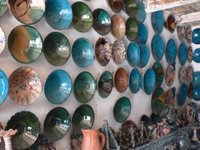 “Istalef is a very beautiful place”, is written in my dari language workbook published in 1977. It was a touristic place known because of it’s beauty and traditional pottery.
“Istalef is a very beautiful place”, is written in my dari language workbook published in 1977. It was a touristic place known because of it’s beauty and traditional pottery.Story about Istalef is good enough to represent typical story of an afghan village. Once it was surrounded by lush orchards growing grapes, roses and wheat. Timuride emperor Babur wrote about its beauty and colours. Zahir Shah, the last king of Afghanistan, used Istalef as a vacation spot.
In the 1998-2002 Taliban ruled Istalef: the trees were cut down and thousands of the villagers left their homes behind. Nowadays someone can hardly find more than ruins. But some families are beginning to return: they build up their homes and kilns, trying to continue
 their traditional pottery business.
their traditional pottery business.I drive to Istalef with Ester and Shoshana, employees of Turquoise Mountain Foundation. Young ladies have to fulfill a hard task. They have a meeting with villagers to discuss how to find some gifted students for TMF craft school. But they are quite sure that the elder of village already have some names in the students’ list – his closest relatives...
The translator advises not to speak about the choice during the meeting. “Just concentrate on introducing the school,” suggests the afghan. In Afghanistan you must proceed very slowly, almost gingerly.
 Istalef is situated in the hillsides with great wide scenery onto Somali plain. There is a hidden little teahouse in the middle of the grove. And the next moment I see something truly unusual in Afghanistan: a group of oriental tourists is stepping down the staircase along the hillsides...
Istalef is situated in the hillsides with great wide scenery onto Somali plain. There is a hidden little teahouse in the middle of the grove. And the next moment I see something truly unusual in Afghanistan: a group of oriental tourists is stepping down the staircase along the hillsides...Ahead there is the villagers’ meeting place: under the shed there are some carpets. Even some flowers are planted around. It is interesting to see how two fragile westerns ladies, wrapped in veils, hold speeches to a large crowd of afghan men. Their talk is politely, respectful and sustained. I think that special oral skills gained in Afghanistan are useful, especially in politics.
After school introduction, most lucrative moment arrives for the local people. Foundation gives
 away to every person present a bag of glaze. Some of the glazes the potters use contain lead, which is very dangerous. The foundation is trying to encourage to use lead-free glazes.
away to every person present a bag of glaze. Some of the glazes the potters use contain lead, which is very dangerous. The foundation is trying to encourage to use lead-free glazes.Before the guy can heave the heavy bag, he must leave his thumbprint on the list. After procedure long steam of villagers waddle towards their houses. Only some of them have a donkey.
Before we leave for Kabul, we stop at the village bazaar. Only for few dollars I buy some pottery. I really like the simple form of the bowls and vases. The deep blue or green color is very impressive, too. The experts say that basic shapes and designs of Afghan pottery have changed a little in 5,000 years. Unfortunately the materials used are low quality: it is hard to find an item without a defect.
No comments:
Post a Comment